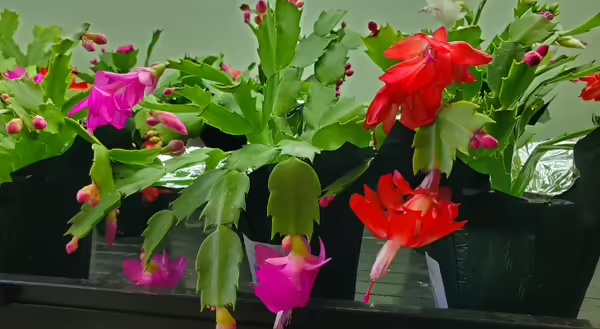
As the holidays roll around, it’s hard not to notice the delightful blooms of holiday cacti. They seem to be everywhere, from the supermarket checkout lane to many a holiday gathering as either garnishes or gifts, which help to illuminate the holiday season.
While these plants make excellent houseplants after the season, their brightening blooms are often elusive in future years. Understanding their needs in nature can help you stack the odds in your favor when considering their care.
Meet the holiday cacti
There are three species of commonly available holiday cacti: Thanksgiving cactus (Schlumbergera truncate), Christmas cactus (Schlumbergera x buckeyi), and Easter cactus (Schlumbergera gaertneri). Although they are members of the cactus family (Cactaceae), defined as succulents with fleshy stems and no true leaves (often replaced by spines), they certainly don’t come from the sunny desert setting I typically associate with Cactaceae.
These cacti are actually tropical plants native to the mountainous rainforests of southeastern Brazil. In their native range, they are either epiphytes or lithophytes, meaning they grow either in trees or on rocks. In both cases, the roots of these plants never touch true soil. They seek out pockets of accumulated organic matter in the bark of trees or cracks in rocks. Ironically, the holiday cacti grow in cool, wet rainforests as opposed to sunny deserts.

All three of these plants were named according to their respective bloom time, with natural flowering in the wild coinciding with their respective holidays. Of the three, Thanksgiving cactus is, by far, the most commercially available species. I have found it much easier to care for than its festive cousins, with Easter cactus being the most difficult to keep in optimal health and flowering.
Both Thanksgiving cactus and Christmas cactus are short-day plants, meaning they flower when days become shorter in length (8-10 hours) and nights are longer (12- 14 hours). Flowering can also be influenced by temperature, so exposure to cooler temps (especially at night) will induce blooms.
For these reasons, holiday cacti are pretty easily manipulated, and the horticulture industry is very good at controlling environmental conditions to ensure flowering occurs at the optimal time for marketing and sales purposes. Often, Thanksgiving cactus is sold this time of year labeled as ‘Christmas cactus.’ In these cases, growers have timed the optimal light and temperature exposure to induce blooms on S. truncate plants around Christmas instead of its natural bloom time at Thanksgiving.


The best way to think about optimal care for your holiday cacti is to consider the natural conditions in which these plants grow. Since they come from mountainous rainforests, the plants experience frequent watering and extremely good drainage. I’ve heard the ideal soil mix described as around 50% peat and 40-50% perlite. A typical succulent potting mix will not quite achieve these conditions, so you may have to create your own. Remember that peat really loses its properties over time, and you will likely need to repot every 3-5 years to maintain drainage.
Nighttime temperatures can get pretty cold for a houseplant in these mountainous locations. Consider locations in your home that get cooler at night, like areas near windows and away from heat vents. To induce flowering, the optimal nighttime temperature exposure is around 55-60°F (daytime reaching 75-80°F), which is difficult to achieve in most homes. However, temperature has been shown to be almost as critical as light and, in some cases, the sole driver of bloom development.
These cacti grow in considerable shade in nature. They cannot tolerate full sunlight and prefer bright indirect light or morning sun if direct. A dark period of 12-14 hours is needed for flowering, and while it may seem like your plant doesn’t get much nighttime light, indoor lighting can have an effect. Starting in August, be aware of nighttime light in their space and just keep the lights off as much as possible. If you are willing to put forth the effort, covering the plant or putting it in a dark closet overnight for a few months can really stimulate flower bud development.
In the end, these plants are incredibly tolerant of many conditions and often grow just fine if not overwatered, even if blooms evade. Like most houseplants, finding that perfect placement in your home may take some experimentation over the years. However, knowing the optimal conditions can help you stack the odds in your favor as you try to find the sweet spot.
For more detailed care information, the University of Wisconsin has an excellent guide available online.